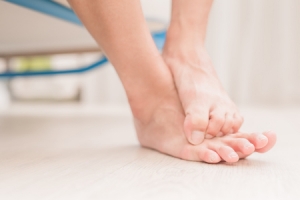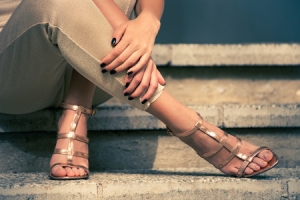Connect With Us
Blogs
Displaying items by tag: fungal toenail
Facts about Psoriasis
During the month of August, we at Superior Foot & Ankle Care Center recognize Psoriasis Action Month. Psoriasis can appear on your legs and feet as well as on other parts of your body. Below are some facts about this condition and what can be done about it.
FACT: Psoriasis is a chronic disease of the immune system. It manifests most often as a skin condition. In people with psoriasis, new skin cells come to the surface too rapidly. This results in an inflammation of the skin.
FACT: It’s estimated that 8-12 million Americans currently suffer from psoriasis.
FACT: Psoriasis often first develops in patients between the ages of 15 and 25, but can strike at any age.
FACT: Researchers believe that the cause of psoriasis is a combination of an inherited genetic tendency for the disease combined with exposure to certain external triggers. Several possible triggers have been identified, including stress, certain medications, an injury or infection. Triggers are not the same for each person.
FACT: There are multiple types of psoriasis and they can appear differently on the skin. Thick patches of skin, redness, blisters, and lesions are some of the possible symptoms. Psoriasis may cause itching and pain.
FACT: Psoriasis can also cause inflammation and pain in your joints, tendons, and ligaments. About one in three patients with psoriasis develop psoriatic arthritis.
FACT: Patients with psoriasis are at an elevated risk for contracting other conditions like cancer, cardiovascular disease, depression, osteoporosis, liver disease, diabetes, and more.
FACT: On your feet and toenails, psoriasis may look like athlete’s foot or fungal toenail infection. For this reason, if you notice any unusual changes in your skin or toenails or you are experiencing unexplained joint pain, contact our Long Beach office by calling: (562) 420-9800 for an appointment. Our podiatrists, Dr. Victoria M. Foley or Dr. Constance Ornelas will examine your feet and determine whether an infection, psoriasis or some other disorder is the source of your discomfort.
Do You Like How Your Feet Look?
Are you comfortable wearing strappy sandals or open-style shoes? If not, does the appearance of your feet have something to do with it? At Superior Foot & Ankle Care Center, we know that several podiatric disorders have unsightly outward signs that can make female patients feel self-conscious about wearing individual shoe styles. Below are some of the most common ones and what you can do about them.
Bunions—a large bump at the base of the big toe is the telltale sign of a bunion. While many patients know how to recognize a bunion, there is a lack of understanding about the condition. A bunion is a progressive condition, meaning it will only get worse over time. That’s why at the first sign of a bunion it’s important that you make an appointment at our Long Beach office (562-420-9800) so that our podiatrists, Dr. Victoria M. Foley or Dr. Constance Ornelas can evaluate it. The foot doctor may want to take an x-ray to use to monitor the progression of the bunion. There are several conservative treatment options available, although only surgery can correct a bunion. The podiatrist will recommend the best treatment based on your individual case.
Haglund’s Deformity—perhaps you know this condition by its more common name—pump bump. A bony enlargement at the back of the heel distinguishes it. When pumps or other shoes with stiff backs rub against the bony protrusion, it can become inflamed and red, causing pain and discomfort. Wearing open-backed shoes and using heel lifts can both help reduce the irritation.
Fungal Toenails—a brownish discoloration of a toenail, along with thickening and crumbling edges can signal a fungal toenail. Although these are often not painful, they are unattractive and can spread to other nails if left untreated. Topical, oral, and laser therapy are all possible treatments for eradicating fungal nails.
You don’t have to hide your feet. If you have a condition that is causing you to want to keep your feet hidden away, contact us and let us help you restore your feet’s natural beauty.
Summer Checklist for Preventing Children’s Foot Problems
Chances are with the end of the school year your child came home with readings lists and other summer work. At Superior Foot & Ankle Care Center we’d like to add one more list: a checklist for taking care of your child’s feet over the summer months. Summer brings a whole new set of activities and options for children, many of which can lead to foot trouble if the proper precautions are not taken. Here are our top tips for keeping children’s feet healthy this season:
Slather on the Sunscreen—many people forget to apply sunscreen to their feet. The skin on your feet is just as susceptible to the harmful effects of UVB and UVA rays as that on the rest of your body. On beach and pool days you should put sunscreen on the tops and bottoms of your children’s feet and reapply after swimming. If your children are wearing sandals or other open shoes and will be out in the sun shopping or sightseeing you should also put sunscreen on their feet then.
Pack the Flip Flops—summertime is high season for athlete’s foot, fungal toenails and warts, all of which are spread by direct contact with the virus, fungi or bacteria that cause them. If you are spending time at a community pool or local beach make sure your child keeps their feet covered around the pool and in changing areas and bathrooms—these are prime hangouts for fungal infections. Encourage your children not to share shoes, socks, towels or any items that touch someone else’s feet.
Inspect Shoes—be sure that your child is wearing shoes that match the activity they are participating in. While flip flops are good for the pool, they can lead to injury if used for playing whiffle ball or other casual summer sports. Also keep an eye on fit—children’s feet grow fast and time spent squeezed into shoes that are too tight can increase the risk of ingrown toenails and fungal infections.
Keep it Clean—wash your children’s feet at the end of every day with a mild soap and warm water. Be sure to dry completely as well, especially between the toes. Trim toenails straight across with no curved edges. If your child’s feet sweat excessively, consider a foot powder to help keep them dry.
If when caring for your child’s feet you notice anything unusual or concerning, or if your child complains of foot pain, don’t hesitate to contact our podiatrists, Dr. Victoria Foley and Dr. Constance Omelas at our Long Beach office by calling 562-420-9800. It’s always better to get a foot concern checked than to wait and have it develop into a serious issue. Enjoy the summer and keep your children’s feet safe!



